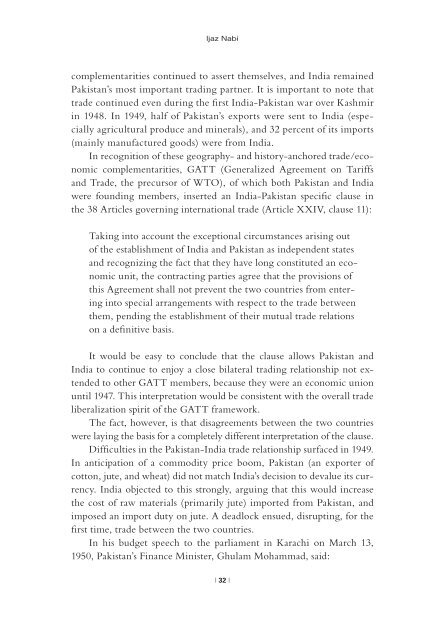You also want an ePaper? Increase the reach of your titles
YUMPU automatically turns print PDFs into web optimized ePapers that Google loves.
Ijaz Nabi<br />
complementarities continued to assert themselves, and <strong>India</strong> remained<br />
<strong>Pakistan</strong>’s most important trading partner. It is important to note that<br />
trade continued even during the first <strong>India</strong>-<strong>Pakistan</strong> war over Kashmir<br />
in 1948. In 1949, half of <strong>Pakistan</strong>’s exports were sent to <strong>India</strong> (especially<br />
agricultural produce and minerals), and 32 percent of its imports<br />
(mainly manufactured goods) were from <strong>India</strong>.<br />
In recognition of these geography- and history-anchored trade/economic<br />
complementarities, GATT (Generalized Agreement on Tariffs<br />
and <strong>Trade</strong>, the precursor of WTO), of which both <strong>Pakistan</strong> and <strong>India</strong><br />
were founding members, inserted an <strong>India</strong>-<strong>Pakistan</strong> specific clause in<br />
the 38 Articles governing international trade (Article XXIV, clause 11):<br />
Taking into account the exceptional circumstances arising out<br />
of the establishment of <strong>India</strong> and <strong>Pakistan</strong> as independent states<br />
and recognizing the fact that they have long constituted an economic<br />
unit, the contracting parties agree that the provisions of<br />
this Agreement shall not prevent the two countries from entering<br />
into special arrangements with respect to the trade between<br />
them, pending the establishment of their mutual trade relations<br />
on a definitive basis.<br />
It would be easy to conclude that the clause allows <strong>Pakistan</strong> and<br />
<strong>India</strong> to continue to enjoy a close bilateral trading relationship not extended<br />
to other GATT members, because they were an economic union<br />
until 1947. This interpretation would be consistent with the overall trade<br />
liberalization spirit of the GATT framework.<br />
The fact, however, is that disagreements between the two countries<br />
were laying the basis for a completely different interpretation of the clause.<br />
Difficulties in the <strong>Pakistan</strong>-<strong>India</strong> trade relationship surfaced in 1949.<br />
In anticipation of a commodity price boom, <strong>Pakistan</strong> (an exporter of<br />
cotton, jute, and wheat) did not match <strong>India</strong>’s decision to devalue its currency.<br />
<strong>India</strong> objected to this strongly, arguing that this would increase<br />
the cost of raw materials (primarily jute) imported from <strong>Pakistan</strong>, and<br />
imposed an import duty on jute. A deadlock ensued, disrupting, for the<br />
first time, trade between the two countries.<br />
In his budget speech to the parliament in Karachi on March 13,<br />
1950, <strong>Pakistan</strong>’s Finance Minister, Ghulam Mohammad, said:<br />
| 32 |


